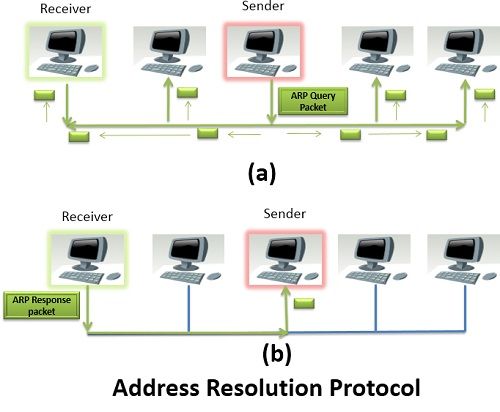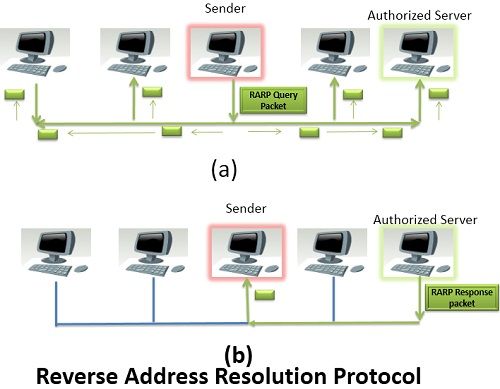 ARP and RARP both are the Network layer protocol. Whenever a host needs to send an IP datagram to another host, the sender requires both the logical address and physical address of the receiver. The dynamic mapping provides two protocols ARP and RARP.
ARP and RARP both are the Network layer protocol. Whenever a host needs to send an IP datagram to another host, the sender requires both the logical address and physical address of the receiver. The dynamic mapping provides two protocols ARP and RARP.
The basic difference between ARP and RARP is that ARP when provided with the logical address of the receiver it obtains the physical address of the receiver whereas in RARP when provided with the physical address of the host, it obtains the logical address of the host from the server.
Let’s study the other differences between ARP and RARP in the comparison table.
Content: ARP Vs RARP
Comparison Chart
| Basis for Comparison | ARP | RARP |
|---|---|---|
| Full Form | Address Resolution Protocol. | Reverse Address Resolution Protocol. |
| Basic | Retrieves the physical address of the receiver. | Retrieves the logical address for a computer from the server. |
| Mapping | ARP maps 32-bit logical (IP) address to 48-bit physical address. | RARP maps 48-bit physical address to 32-bit logical (IP) address. |
Definition of ARP
ARP (Address Resolution Protocol) is a network layer protocol. As ARP is a dynamic mapping protocol, each host in the network knows the Logical address of another host. Now, suppose a host needs to send the IP datagram to another host. But, the IP datagram must be encapsulated in a frame so that it can pass through the physical network between sender and receiver.
Here, the sender needs the physical address of the receiver so that it is being identified that to which receiver the packet belong to when the packet travel in the physical network.
For retrieving the physical address of the receiver the sender performs the following action.
- The sender sends the ARP query packet on the network which is broadcasted to all the other host or router present in the network.
- The ARP query packet contains the logical and physical address of the sender and the logical address of the receiver.
- All the host and router receiving the ARP query packet process it but, only the intended receiver identifies its logical address present in the ARP query packet.
- The receiver then sends ARP response packet which contains the logical (IP) address and physical address of the receiver.
- The ARP response packet is unicast directly to the sender whose physical address is present in the ARP query packet.
 Definition of RARP
Definition of RARP
RARP (Reverse Address Resolution Protocol) is also a network layer protocol. RARP is a TCP/IP protocol that allows any host to obtain its IP address from the server. RARP is adapted from the ARP protocol and it is just reverse of ARP.
RARP perform following steps to obtain an IP address from the server.
- The sender broadcast the RARP request to all the other host present in the network.
- The RARP request packet contains the physical address of the sender.
- All the host receiving the RARP request packet process it but, the authorized host only which can serve RARP service, responds to the RARP request packet such host are known as RARP Server.
- The authorized RARP server replies directly to requesting host with the RARP response packet which contains IP address for the sender.
 RARP is outdated now because of two reasons. First, the RARP is using the broadcast service of the data-link layer; that means the RARP must be present at each network. Second, RARP only provides IP address but today the computer also need other information.
RARP is outdated now because of two reasons. First, the RARP is using the broadcast service of the data-link layer; that means the RARP must be present at each network. Second, RARP only provides IP address but today the computer also need other information.
Key Differences Between ARP and RARP
- The full form of ARP is Address Resolution Protocol whereas, the full form of RARP is Reverse Address Resolution Protocol.
- ARP protocol retrieves the physical address of the receiver. On the other hand, the RARP protocol retrieves logical (IP) address of the protocol.
- ARP maps 32 bit logical (IPv4) address to a 48-bit physical address of the receiver. On the other hand, RARP maps 48-bit physical address to 32-bit logical address of the receiver.
Conclusion
RARP has been replaced by BOOTP and DHCP.
d says
nice article
Faris Mubarek says
Clear and helpful explanation. Thank you for the post.
Maharshi Pandya says
Nice
It is helpful
Rupal Rajani says
Very helpful keep making such content on more topics
Chaitan Kailas Wani says
It’s very helpful for everyone
Hanibal says
Awesome